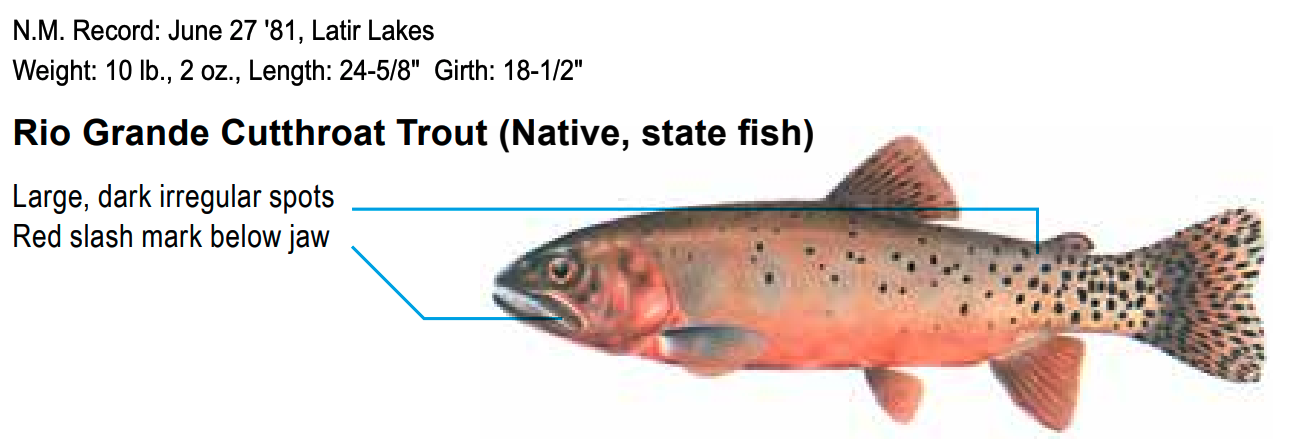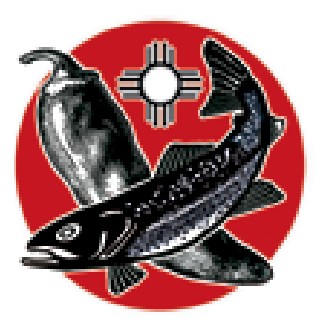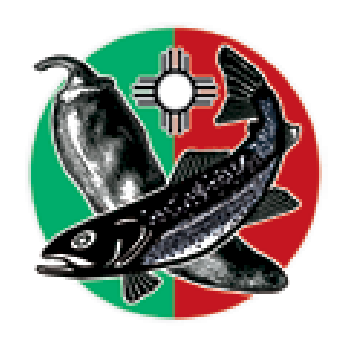Cold Water Regulations
Cold Water Game Fish
Rainbow Trout

Brown Trout

Brook Trout

Lake Trout

Cutthroat Trout

Gila Trout (Native)

Kokanee Salmon

Kokanee Salmon

Where To Find Cold Water Species
Rainbow Trout
NMDGF stocks rainbow trout in a variety of waters to provide angling opportunities. The Albuquerque area drains and Tingley Beach are stocked weekly during the winter months. The Red River, San Juan River and Fenton Lake, as well as Monastery Lake, provide great opportunities for rainbow trout.
Brown Trout
Numerous wild populations of brown trout occur throughout New Mexico. The Rio Grande Gorge supports a thriving population of brown trout in a wild setting. Other waters include the Pecos River, San Juan River, Rio Guadalupe in the Jemez and the Cimarron River below Eagle Nest Dam.
Gila Trout
A number of streams in southwest New Mexico are open to Gila trout angling. Whitewater Creek at the Catwalk Recreation Area near Glenwood, and Black Canyon in the East Fork Gila watershed are easily accessible and excellent locations to spend a day fishing for a native Gila trout. For anglers ready to hike, Mineral Creek near the town of Mogollon and Mogollon Creek in the mainstream Gila watershed provide opportunities to catch a wild Gila trout while enjoying beautiful scenery. Gila trout are also stocked in Sapillo Creek below the Highway 15 bridge and in the Gila Forks area during cooler months of the year.
Rio Grande Cutthroat Trout
Anglers can pursue native Rio Grande cutthroat trout in many of New Mexico’s streams, rivers and lakes. Streams including Comanche Creek in the Valle Vidal and Jack’s Creek in the Pecos watershed are easily accessible from roads. For the adventurous angler, hiking up the Rio de las Vacas, El Rito or the upper Pecos watershed provides great fishing in some of the most beautiful landscapes in New Mexico. Rio Grande cutthroat trout are also stocked in the state’s high mountain
lakes, such as the Trampas Lakes and Horseshoe Lake, and in rivers including the Rio Grande and Rio Chama.
Kokanee
Navajo lake provides great opportunities for kokanee trolling. Eagle Nest, El Vado and Heron lakes are also stocked with kokanee. In the fall kokanee snagging is a popular activity at these waters.
Brook Trout
Brook trout are uncommon in New Mexico. Most brook trout populations occur in smaller and more difficult to access streams around the state. Two more easily accessible streams are Cabresto Creek above Questa and Tecolote Creek near Las
Vegas. Brook trout may also be found at Cabresto Lake, Hopewell Lake and Cruces Basin Wilderness.
Lake Trout
In the 1980s, lake trout were introduced at Heron Lake. Since that time, a self- sustaining population has become well established. Fishing is best during spring and fall months.
Cold Water Regulations
General Information
In New Mexico cold water species include trout and salmon. Catchable-size trout that have been reared at hatcheries are stocked in more heavily fished waters. Smaller trout and salmon are stocked where waters can better support their growth. Some waters suit native Rio Grande cutthroat trout populations, while other waters are better suited for naturally reproducing non-native brown trout, and still others that may be too warm during summer are cool enough in winter to be stocked with hatchery-raised rainbow trout.
Free Gila Trout Fishing Permit
Gila Trout Permit Waters: A Gila Trout Fishing Permit is required to fish Black Canyon, Gilita Creek, Mineral Creek, Mogollon Creek, Sapillo Creek, West Fork Gila River (headwaters to East Fork confluence), Whitewater Creek, and Willow Creek (including tributaries). This permit is free and available online: www.wildlife.state.nm.us, by telephone: 1-888-248-6866 and at all license vendors and NMDGF offices. Please do not obtain this permit unless planning to fish in one of the waters listed above.
Bag Limits for Trout and Kokanee Salmon
Brown trout, brook trout, rainbow trout, Gila trout or kokanee salmon - 5 per Day - 10 in Posession
- Bag limit of 5 fish is considered any combination of trout and/or salmon with the exception that no more than 2 lake trout and/or 2 cutthroat trout may be included in the limit.
- Trout bag is 3 trout at Laguna del Campo.
- Possession of kokanee salmon is not permitted at Heron Lake and Willow Creek during the closed season, October 1–November 10.
- Bag limits may be different for Special Trout Waters.
- Gila trout bag limits are reduced or are strictly catch-and-release in several waters
Lake trout - 2 per Day - 4 in Posession
Cutthroat trout - 2 per Day - 4 in Posession
- Cutthroat bag limit is 5 cutthroat trout at Seven Springs Hatchery Kid’s Pond. No more than 5 trout, including cutthroat, may be harvested at Seven Springs Kid’sPond.
- Any trout with red slash marks below the jaw is considered a cutthroat.
Winter Trout Waters
When water temperatures are cool, between November 1–March 31, Winter Trout Waters are stocked with hatchery-reared rainbow trout.
Streams and Rivers: Black River (1 mile upstream to 1 mile downstream of Higby Hole); Pecos River (from the southeast boundary of VillanuevaState Park downstream to Santa Rosa Lake); Rio Grande (Elephant Butte Reservoir to Caballo Lake).
Lakes: Alumni Pond, Bataan, Bear Canyon, Bill Evans, Bosque Redondo, Bottomless Lakes State Park, Carlsbad Municipal, Carrizozo, Chaparral, Corona, Dennis Chavez, Escondida, Eunice, Greene Acres, Grants Riverwalk Pond, Green Meadow, Harry McAdams Ponds, Jal, Lake Van, Liam Knight Pond, Ned Houk, Oasis State Park, Perch Lake, Rancho Grande Ponds, Sumner Lake Stilling Basin, Roswell Kid’s Pond (Spring River Park), Tingley Beach, Young Pond.
Drains: Albuquerque, Belen Riverside, Bernalillo, Corrales and Peralta.
Kokanee Salmon
Special Kokanee Salmon Snagging Season
Kokanee are land-locked sockeye salmon. Although not native to the Southwest, kokanee thrive in some of New Mexico’s deeper and colder plankton-producing lakes. In late fall, large schools of four-year-old kokanee gather to spawn and die.
A popular method for catching kokanee is snagging, the intentional taking of fish by hooking the body rather than the mouth. Kokanee are the only fish that may be legally snagged, and only during Special Kokanee Snagging Season. If another species is caught by snagging, it must be immediately returned to the water.
Each autumn NMDGF collects millions of kokanee eggs and milt to fertilize eggs and hatch fry. The young fry are used to stock Heron Lake, Navajo Lake, El Vado Lake and Eagle Nest Lake. The success of these collection operations is essential to maintain vibrant and healthy fisheries for anglers to enjoy. As a result, Heron Lake, Willow Creek and designated no-wake areas at Navajo Lake have seasonal closings (see listing below), and no kokanee salmon may be in possession while fishing during these closures at Heron Lake and Willow Creek.
Snagging Season Dates by Location
October 1–December 31: Open at Rio Chama (El Vado Lake to west boundary of Rio Chama Wildlife and Fishing Area), Navajo Lake (excluding buoyed no-wake areas and shoreline within the no-wake areas at the Pine River Boat Ramp and Simms Boat Ramp), Pine River, El Vado Lake and Eagle Nest Lake.
October 1–November 10: Closed at Heron Lake and Willow Creek.
November 11–December 31: Open at Heron Lake and Willow Creek.
Bouyed no-wake areas and shoreline within the no-wake areas at the Pine River Boat Ramp and Simms Boat Ramp are closed to kokanee snagging throughout the snagging season.
Bag Limit (during Special Kokanee Salmon Snagging Season)
Kokanee trout - 12 per Day - 24 in Posession
Special Trout Waters
General Information
Special Trout Waters (STW) are managed to enhance the unique angling opportunities available in New Mexico. Regulations vary for STWs — some are managed to produce trophy-size trout, some to improve conservation of native trout, and others to enhance the overall trout population structure and density. Regulations are tailored to each water and may include reduced bag limits, catch-and-release for native Gila trout and Rio Grande cutthroat trout or increased harvest for nonnative fish species. Many STWs require artificial flies and lures with a single, barbless hook. It is illegal to disturb rocks, plants, or sediment to attract fish. Chumming
and baitfish use are not allowed in any STW. By following these regulations anglers help to conserve healthy fisheries in New Mexico and promote high-quality fishing experiences for everyone.
Designations of Special Trout Waters (STW)
The New Mexico Department of Game and Fish has established three designations for STWs: Red Chile Water, Green Chile Water and Xmas Chile Water. Each designation is easy to remember, and signs with symbols are posted at STWs with bag limits and tackle restrictions.
Red Chile Water - Catch-and-release with tackle restrictions

Green Chile Water - Two (2) trout daily bag limit with tackle restrictions

Xmas Chile Water - Two (2) trout daily bag limit with any legal tackle

Red Chile Water

Tackle restrictions: artificial fly or lure with a single, barbless hook.
Catch and release only
Capulin Creek from the confluence with the Rio Grande to its headwaters.
Cimarron River from the east end of Tolby Campground downstream 1.4 miles to the first U.S. Highway 64 bridge.
Jack’s Creek from the waterfalls located 0.25 miles downstream of N.M. Highway 63 crossing upstream to its headwaters.
Mogollon Creek from barrier at waterfalls near U.S. Forest Service Trail 153 upstream to confluence of Trail Canyon. Open from July 1–October 31.
Nabor Creek and Nabor Lake on the Sargent Wildlife Management Area.
Pecos River in the Pecos Wilderness above Pecos Falls.
Rio Chama from USGS gauging station located below Cooper’s Landing to the Rio Nutrias confluence.
Rio Costilla from its confluence with Latir Creek upstream 2.4 miles to the Valle Vidal boundary.
Rio Las Animas within Gila National Forest, Black Range District.
Rio Valdez in the Pecos Wilderness from the waterfall barrier 0.8 miles below FS Trail 239 upstream to its headwaters.
San Juan River from Navajo Dam downstream 3.75 miles to the Crusher Hole Day Use Area. It is illegal to fish with more than 2 flies or lures on a single line when fishing the STW of the San Juan River.
Tingley Beach South Pond within the Albuquerque Conservancy Park.
Valle Vidal All streams. Open July 1–December 31.
Catch & Release Tips
Many game fish in New Mexico have restricted bag and/or size limits that require immediate live release back into the water where taken. To ensure healthy release, follow these suggestions:
- Land the fish quickly and don’t play it to exhaustion.
- Use a landing net whenever possible.
- Keep the fish in the water.
- Do not squeeze or grab any part of the fish. Wet your hands first if you must handle the fish.
- Gently remove the hook (barbless hooks are easier).
- If the hook is swallowed deeply, cut the leader. A fish’s body fluids will dissolve the hook in a matter of days.
- Let a tired fish recover. Hold it by the tail in the water with one hand and gently support it from below and just behind the head until it swims away.
- Never toss or throw a fish back into the water.
Red Chile Water (Native Trout Conservation)

Tackle restrictions: Artificial fly or lure with single, barbless hook
Catch-and-release only for Rio Grande cutthroat trout and Gila trout
Bag limit unlimited for rainbow trout, brown trout and brook trout
Black Canyon from Forest Service Road 150 (North Star Mesa Road) crossing upstream to its headwaters. Open July 1–October 31.
Cabresto Creek upstream from Cabresto Canyon to headwaters, not including Lake Fork or Cabresto Lake.
Canada Tio Grande within the Carson National Forest, excluding private land.
Columbine Creek from its confluence with the Red River upstream to its headwaters.
Frijoles Creek (Taos County) from its confluence with Rito de la Olla upstream to its headwaters.
Gavilan Creek from its confluence with the Rio Hondo upstream to its headwaters.
Italianos Creek from its confluence with the Rio Hondo upstream to its headwaters.
Leandro Creek within the Valle Vidal. Open July 1–December 31.
Palociento Creek from its confluence with Rito de la Olla upstream to its headwaters.
Rio Cebolla from the Seven Springs Day Use Area upstream to the headwaters, including McKinney Pond.
Rio de Las Vacas from the fish migration barrier located 0.2 miles upstream of FS Road 70 crossing to its headwaters.
Rio Santa Barbara from the West Fork and Middle Fork confluence upstream to its headwaters, including the East Fork.
Rito del Padre from the fish migration barrier located about 0.3 miles upstream of the confluence with the Rito Sebadilloses to its headwaters, including Rito de los Chimayosos and Rito Maestas.
South Fork Rio Hondo (Taos County) from its confluence with the Rio Hondo upstream to its headwaters.
Tanques Creek from FS Road 93 crossing upstream to its headwaters.
West Fork Luna Creek from the Carson National Forest property boundary upstream to its headwaters.
Yerba Creek from its confluence with the Rio Hondo upstream to its headwaters.
Green Chile Water

Tackle restrictions: Artificial fly or lure with single, barbless hook
Bag limit two (2) trout only
Pecos River in the box canyon 0.5 miles upstream of its confluence with the Mora River to 0.2 miles downstream of the bridge crossing at Cowles.
Red River from its confluence with Goose Creek 1.1 miles upstream to the Carson National Forest boundary.
Rio Chama within the boundaries of the Rio Chama Wildlife and Fishing Area from Heron Reservoir outlet 2.9 miles upstream to Cottonwood Flats.
Rio de Los Pinos from FS Road 284 and 87A, 2.5 miles upstream to the private property boundary.
Rio Guadalupe from its confluence with Deer Creek Landing upstream 6.0 miles to Stable Canyon.
Rio San Antonio from the San Antonio Hot Springs pedestrian bridge upstream 2.0 miles to the Valles Caldera National Preserve boundary.
Sargent Wildlife Management Area for all waters within or adjacent to the WMA including the Rio Chamita, Sixto Creek, and Rio Chama, excluding Nabor Creek and Nabor Lake.
Shuree Ponds on the Valle Vidal. Open July 1– December 31.
Valles Caldera National Preserve all waters within preserve.
Green Chile Water

Any legal tackle
Bag limit two (2) trout only
Gilita Creek and Willow Creek from its confluence with Snow Creek upstream to its headwaters including Little Turkey Creek.
Mineral Creek from its confluence with San Francisco River to its headwaters.
Red River from its confluence with the Rio Grande upstream to the lower walking bridge at Red River State Fish Hatchery.
Rio Chama from the river-crossing bridge on U.S. Highway 84 at Abiquiu upstream 7.0 miles to the base of Abiquiu Dam.
Rio Grande from the Colorado state line downstream to the Taos Junction Bridge at N.M. Highway 567.
Rio Ruidoso from Fridenbloom Drive upstream to the Mescalero Reservation. Whitewater Creek from the Catwalk National Recreation Trail parking area upstream to the headwaters, including all tributaries.
